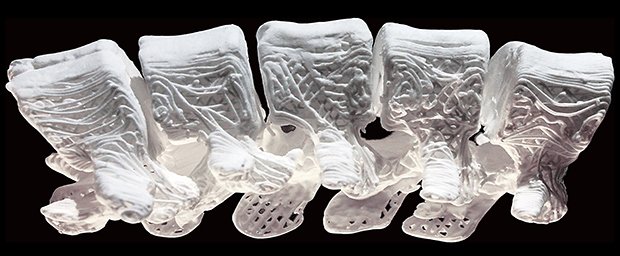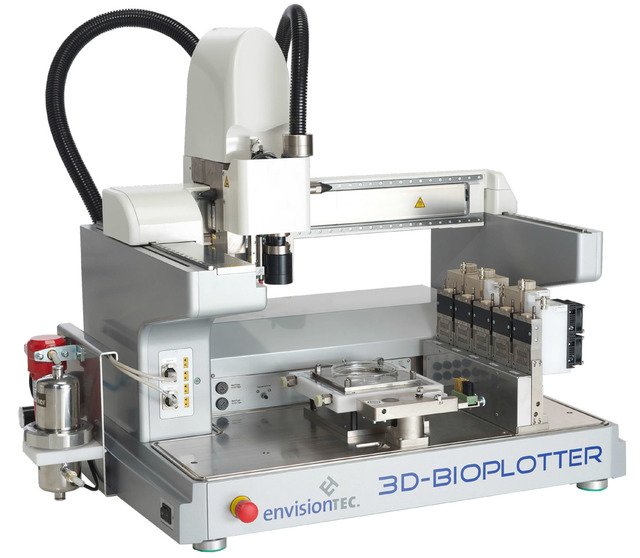Created biomaterial for 3D-printing time human bones

Several temporary human vertebrae, printed the 3D-printer. Photo: Adam E. Jakus
Attempts to create materials for 3D-printing time human bones (osteoregenerativnye biomaterials) made repeatedly. Unfortunately, until now, they suffer from several drawbacks. Among them - the inability to quickly and accurately reproduce the new bone, the high cost and limited production capabilities, processing complexity of the surgical operation.
The new biomaterial is deprived of all these shortcomings. If all tests are successful, then after a few years people will be able to get a solid, superelastic and cheap artificial bones that will biodegrade in the body for several years (they are gradually replacing the natural bone tissue). Most interesting is that the technical process of extrusion material at room temperature, in theory, allow the bones even print on your home printer.
As scientists write new material HB (from hyperelastic "bone") is 90% by weight of hydroxyapatite and 10% of the PCL.
Hydroxyapatite Ca10 (PO4) 6 (OH) 2 is the main mineral component of natural human bone. Most of the bone it is about 50% of the total weight, and in the dental enamel - 96%. In medicine, a synthetic analogue of the long used in traumatology, orthopedics and bone surgery as a filler, a replacement of the lost bone. In dentistry, it is also used in toothpastes as remineralizing element that strengthens tooth enamel.
But polycaprolactone (PCL) is absent in biological materials. This is a biodegradable polyester that is used in industry for the production of polyurethanes. Because it makes biodegradable bags. In medicine, PCL also used as suture material and a thermal bioresorbable implant long-acting (filler) having the ability to stimulate the growth of fibrous tissue and fill up the volume at the expense of its own components. Many tablets of capsules releasing PCL, they dissolve in the body. In addition, PCL mass used in 3D-printing as a material for prototyping. The properties of the viscous PCL like a natural gum such as gutta-percha.
Experiments showed that such an artificial bone structure can quickly print at room temperature at a speed of up to 275 cm3 / hr extrusion, that is by pushing or viscous melt material forming a thick paste through the hole. To create a viscous mixture, which is loaded into the printer, use a special solvent.
Print implant traditional extruded at room temperature - it is a great advantage because other bone implants are at high temperature with the use of lasers, explains Ramil Shah, lead author of the research and the head of the research team from Northwestern University (USA) . Sami researchers during experiments using a commercially available printer 3D-Bioplotter System manufactured by EnvisionTec. This device can be purchased at prices ranging from $ 250,000 to $ 300,000.
Of course, in the household of such a printer would be too expensive acquisition. But every hospital or surgery center may well afford it. In fact, even individuals can pool their savings to buy such printers and print new bone itself or pet if necessary (of course, for the operation, it is desirable to turn to a professional surgeon).

Artificial bone show good mechanical properties: tensile deformability (strain to failure) from 32% to 67%, modulus of 4 to 11 MPa. Therefore, it is elastic and durable material. It is also characterized by a high absorption capacity (porosity 50%), maintains the viability and propagation of living cells. Tests have shown that the material not interfere with the formation of bone marrow mesenchymal stem cells.
So far, the biocompatibility HB tested only in laboratory animals, but these experiments were very promising. Subcutaneous implants in mice did not cause rejection within 7-35 days. In rats, the bone graft has been installed in the posterolateral portion of the spine (posterolateral arthrodesis) for 8 weeks, it was observed the formation of new bone. Also held on the primacy of experience with damage to the skull (4 weeks).
During all experiments HB did not cause a negative reaction of the immune system. At the same time normal vascularisation (blood vessels formation) was observed, artificial bone to quickly integrate into the surrounding tissue quickly ossified and supported the growth of new bone tissue without any additional intervention. It is expected that as the biodegradable material it will take place live natural bone tissue with blood vessels.
It is important to note that while the strength and elasticity of the material is not new and brittle not brittle like most other implants. That is, the surgeon can cut a fragment of an artificial bone without splintering - a common problem with other implants.
The researchers hope that they will get permission to begin human trials within five years. Currently in the United States, no material for 3D-printing is not approved by regulatory authorities as a regenerative bone material. HB could be the first.
I think thats amazing science has come along way since i was a kid